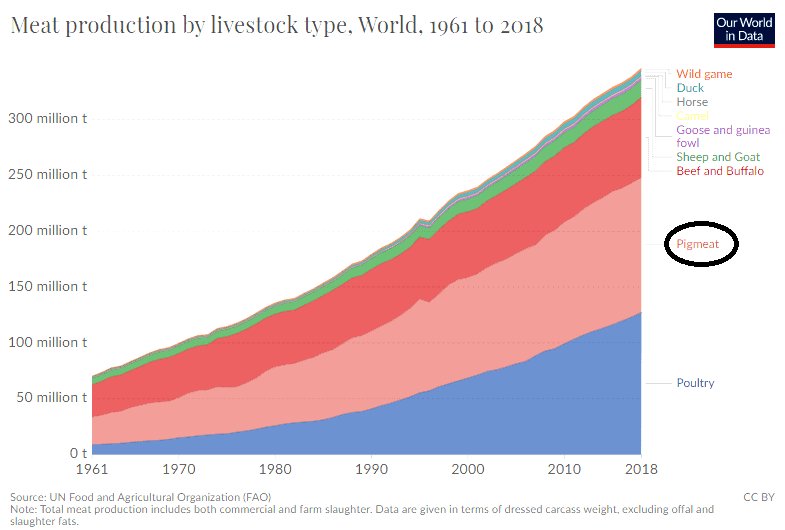Pork reigns as a formidable meat. Acknowledging its versatility and delicious flavor profiles, pork has long been beloved across cultures worldwide; from crispy bacon to succulent ham. However, this beloved protein doesn't come without controversy; while it may appear popular on plates and palates worldwide, an unpleasant truth lies behind its juicy exterior that any discriminating diner must consider when considering purchasing this delicacy.
Have you ever found yourself asking whether pork is good for you? Well, be prepared for an eye-opener when the answer comes back with its devastating truth: pork may actually be one of the least healthful meats to consume. "Why?", may be heard you ask through mouthfuls of succulent pork belly. Let us provide further clarity.
Let's talk cholesterol for a minute. While red meat is often maligned for its high levels of this sticky substance, pork often goes underappreciated despite having more. When considering how quickly and thoroughly bacon sizzles when cooking it on the stovetop, one can only imagine its impact on their arteries.
Don't stop there! If the cholesterol-laden pork hasn't put off your appetite yet, think about this: in addition to being loaded with antibiotics and hormones meant to increase animal growth while stave off disease, these additives may have harmful side effects for human consumers too - everything from serious gut issues to an increased risk of cancer! You definitely don't want these unwanted products on your plate!
Here it is - an eye-opener about pork that will leave you shaking in your boots! Whether or not you are an enthusiast of this delicious treat, we hope this post has shed some light on this matter and made an impressionable impression upon you.
I. High Cholesterol in Pork
Pork can be considered unhealthy for various reasons, ranging from its high cholesterol content and saturated fat levels. Cholesterol - a fat-like substance found in animal products such as pork - can accumulate to dangerously high levels in pork products, leading to heart disease and stroke symptoms as it clogs arteries and constricts them. When compared with other meats like chicken or fish, pork tends to contain significantly more cholesterol - even in leaner cuts -- than other choices, with three ounces serving of cooked tenderloin providing up to 73 milligrams versus an equivalent serving of cooked chicken breast!
Pork contains more fatty acids than either chicken or fish, leading to higher cholesterol counts in the body, particularly saturated fats which increase levels of cholesterol in our system. But it is important to understand that not all cholesterol is harmful - only when levels become excessive can health complications arise. The American Heart Association suggests individuals limit daily cholesterol consumption to below 300 milligrams while those with higher levels should reduce it further - in order to decrease risks such as cardiovascular disease.
Notwithstanding its many potential downsides, eating pork does not need to be detrimental. There are ways of mitigating risks when consuming pork; selecting leaner cuts of pork and trimming any visible fat before cooking can reduce cholesterol levels; cooking it using healthier methods such as grilling or baking is often preferable over frying, which adds extra fat content; ultimately it is possible to enjoy pork as part of a balanced diet while still minimising potential health risks by doing so in moderation and choosing more healthful preparation and cooking methods.
Learn more at Healthline.com about High Cholesterol in Pork.II. High Cholesterol in Pork
Antibiotics and hormones used in factory farming of pork contribute substantially to its unhealthy nature. Farmers use antibiotics and hormones in order to stimulate growth, combat disease, and ensure optimal swine health - however this approach can have serious negative repercussions for both pigs and consumers alike.
There is ample evidence showing that eating meat from antibiotic-exposed animals could increase antibiotic resistance in humans, with excessive antibiotic usage contributing to resistance amongst us humans and making antibacterial agents less effective in treating human infections. Furthermore, hormones used by livestock could have unintended side effects which we still need to understand in detail.
Animals raised in cramped and unhygienic enclosures are highly susceptible to diseases, necessitating increased antibiotic use in order to keep them healthy - this puts public health in jeopardy, raising questions regarding our food production methods and the lasting repercussions associated with such practices.
To reduce exposure to antibiotics and hormones present in pork products, organic and grass-fed varieties should always be preferred whenever possible. Raised more humanely under certification programs like Animal Welfare Approved ensures these animals are cared for healthily and humanely.
Antibiotic and hormone use during pork production is one of the primary factors contributing to its unhealthiness, especially at factory farms with their cramped conditions that lead to increased use of antibiotics and hormones. Opting for organic grass-fed pork products as well as supporting farmers who practice ethical farming practices are among the best ways to lower risks associated with eating pork products.
III. Antibiotics and Hormones in Pork
Pork consumption comes with several health risks that go beyond cholesterol and hormone issues; among these hazards are foodborne illnesses and salt content in processed pork products. We will explore two of these issues here.
Foodborne illnesses
Pork has long been recognized as an agent of foodborne illnesses like Salmonella, Listeria and E. coli contamination. When consumed uncooked or undercooked pork can transmit these bacteria that cause various levels of food poisoning from mild stomach upset to serious medical emergencies that require hospitalization.
To minimize foodborne illnesses, it is vital that pork be cooked to an ideal temperature of at least 145 Fahrenheit before consumption. Furthermore, cleaning hands, surfaces or implements properly when meal prep occurs can prevent cross-contamination with diseases that could spread further.
Salt content in processed pork products
Pork products such as bacon, ham and sausage may contain substantial amounts of sodium - an essential nutrient for human bodies; however excessive sodium consumption can result in increased blood pressure as well as potential health hazards like heart disease, kidney disease and stroke.
For effective sodium management, it is imperative that consumers carefully review food labels and opt for lower sodium alternatives whenever feasible. Furthermore, decreasing consumption of processed pork products while favoring whole pork cuts should also help limit sodium intake.
Cancer risks
Finally, evidence suggests a correlation between excessive pork consumption and an increase in cancer risks, particularly colon cancer. High levels of saturated fat present in pork products could aid cancer cell development within our bodies; although its exact connection remains elusive; it would be prudent to factor this possibility when planning your daily pork portions.
Conclusion: It is crucial that pork consumption be limited and that only whole cuts be eaten. Pork consumption poses additional health threats such as the risk of foodborne illnesses, sodium-laden processed products and cancer; so due care should be taken when adding pork products into your daily diet plan.
IV. "Other Health Risks Associated with Pork Consumption"
Are the health risks associated with pork consumption making you uncomfortable? There are a plethora of alternative protein sources that you can incorporate into your diet as an alternative protein source, including options such as:
1. Chicken
An excellent lean protein source with significantly lower levels of cholesterol and fat than its porkine equivalent.
2. Fish
An abundance of protein coupled with healthy fats for sustained energy, all while remaining relatively low in cholesterol content.
3. Legumes
Legumes provide an exceptional source of plant-based proteins like lentils, chickpeas and beans while being relatively low in both fat and cholesterol levels.
4. Tofu
An outstanding source of plant-based protein and boasting low levels of fat, cholesterol and sodium - offers an exceptional alternative with regard to nutrition.
Pork can remain part of a nutritious, well-rounded diet when consumed in moderation and raised using sustainable practices, and cooked using methods which minimize risk. To optimize its benefits and limit potential downsides.
Pork can often be considered unhealthy by many. Its high cholesterol levels can put individuals at risk of foodborne illness, while processed pork options often contain antibiotics and hormones which increase health concerns while potentially increasing cancer risks associated with its consumption. When consumed carefully and in moderation however, pork can make a nutritious part of a balanced diet and be enjoyed safely while adhering to proper health practices.
Conclusion
In conclusion, by harnessing knowledge and making intentional, well-informed food choices, you can enjoy pork without jeopardizing both your physical and emotional well being. While many risks have been mentioned for eating pork products, with careful consideration and moderation it remains an enjoyable part of diets worldwide. Remember: Being informed fosters a powerful sense of agency when making decisions which lead to healthier, happier outcomes!




